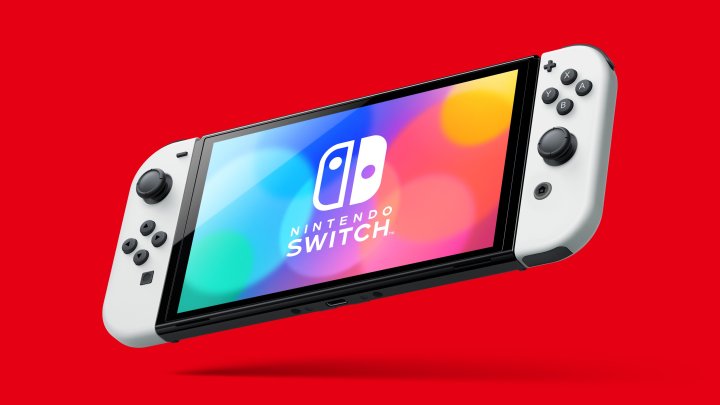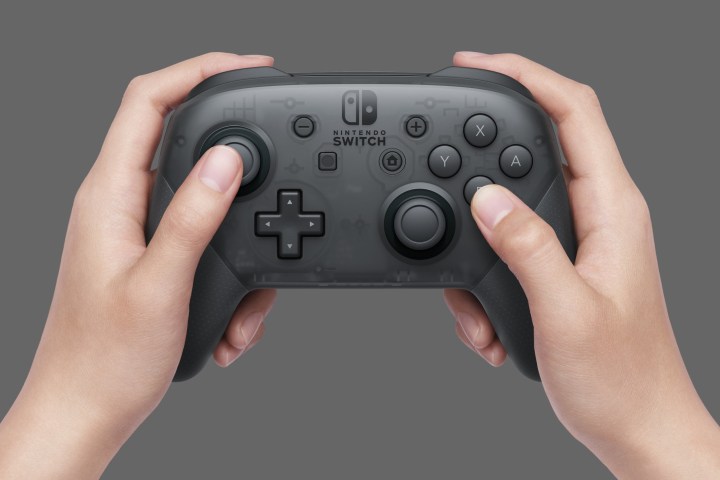It’s common for Nintendo to develop hardware iterations, particularly with its handheld devices. This rings true with its Nintendo Switch line of systems. So far, we’ve seen the original Nintendo Switch, the HAC-001(-01) model with a better battery life, the Nintendo Switch Lite, and now, the Nintendo Switch OLED. These models all have different features and benefits, possibly making it tough to choose which one is best for you.
The Nintendo Switch OLED is the newest addition to the family and is available across various retailers. Whether you’re an existing Nintendo Switch owner or you’re someone looking to buy one for the first time, you’ll want to be aware of all the options. And that’s where we come in.
Here, we’ll break down the difference between the Nintendo Switch, the Switch Lite, and the Switch OLED to help you make an informed purchase.
Recommended reading:
- 8 problems the Nintendo Switch OLED model doesn’t fix
- Switch OLED vs. Switch Lite
- Switch OLED vs. Switch
| Nintendo Switch | Nintendo Switch Lite | Nintendo Switch OLED | |
| Size | Approximately 4 inches high, 9.4 inches long, and .55 inches deep (with Joy-Con attached) | Approximately 3.6 inches high, 8.2 inches long, and .55 inches deep | 4 inches high, 9.5 inches long, and .55 inches deep (with Joy-Con attached) |
| Weight | .66 pounds (.88 pounds with Joy-Con controllers attached) | Approximately .61 pounds | Approximately .71 pounds (.93 pounds with Joy-Con controllers attached) |
| Screen | Multi-touch capacitive touch screen / 6.2-inch LCD Screen / 1280 x 720 | Capacitive touch screen / 5.5-inch LCD / 1280×720 resolution | Multi-touch capacitive touch screen / 7.0-inch OLED screen / 1280×720 |
| CPU/GPU | NVIDIA Custom Tegra processor | NVIDIA Custom Tegra processor | NVIDIA Custom Tegra processor |
| Storage | 32 GB of internal storage (microSD card expandable) | 32 GB of internal storage (microSD card expandable) | 64 GB (microSD card expandable) |
| Wireless | Wi-Fi (IEEE 802.11 a/b/g/n/ac) | Wi-Fi (IEEE 802.11 a/b/g/n/ac) | Wi-Fi (IEEE 802.11 a/b/g/n/ac compliant) |
| Video output | Up to 1080p via HDMI in TV mode and up to 720p via built-in screen in tabletop mode and handheld mode | N/A | Up to 1080p via HDMI in TV mode / Up to 720p via built-in screen in Tabletop mode and Handheld modes |
| Audio output | Compatible with 5.1ch Linear PCM output with output via HDMI | N/A | Compatible with 5.1ch Linear PCM output / Output via HDMI connector in TV mode |
| Speakers | Stereo | Stereo | Stereo |
| Buttons | Power button / Volume button | Left Stick, Right Stick, A, B, X, Y, L, R, ZL, ZR, +, – Buttons, Control Pad, Power Button, Volume Button, HOME Button, Capture Button | Power button / Volume button |
| USB connector | USB Type-C | USB Type-C | USB Type-C |
| Headphone/mic jack | 3.5mm 4-pole stereo (CTIA standard) | 3.5mm 4-pole stereo (CTIA standard) | 3.5mm 4-pole stereo (CTIA standard) |
| Game card slot | Nintendo Switch game cards | Nintendo Switch game cards | Nintendo Switch game cards |
| microSD card slot | Compatible with microSD, microSDHC, and microSDXC memory cards | Compatible with microSD, microSDHC and microSDXC memory cards | Compatible with microSD, microSDHC, and microSDXC memory cards |
| Sensor | Accelerometer, gyroscope, and brightness sensor | Accelerometer / gyroscope | Accelerometer, gyroscope, and brightness sensor |
| Operating environment | 41-95 degrees / 20%-80% humidity | 41-95 degrees F / 20%-80% humidity | 41-95 degrees / 20%-80% humidity |
| Internal battery | Lithium-ion battery/4310mAh | Lithium-ion battery / battery capacity 3570mAh | Lithium-ion battery / 4310mAh |
| Battery life | Approximately 4.5 to 9 hours | Approximately 3 to 7 hours | Approximately 4.5 to 9 hours |
| Charging time | Approximately 3 hours | Approximately 3 hours | Approximately 3 hours |
| DT review | 4/5 stars | 4/5 stars | 4/5 stars |
| Availability | Available now | Available now | Available now |
Design and features

All three systems vary in design and support a multitude of features across the board. Starting with the regular Nintendo Switch, it can be used in handheld, tabletop, or TV mode, hence its name. Out of the box, it comes with a dock that can be connected to a TV, allowing you to “switch” it from a handheld device to a home console. The system also comes with two Joy-Con controllers — one for each side of the system — and can be attached to a Joy-Con Grip to function similarly to a standard controller.
You can use the kickstand on the back of the system to set it on a flat surface and play in tabletop mode — perfect for those traveling with company. The system supports multiple players and is a lot of fun when used in tabletop mode.
The Nintendo Switch OLED works the same but has a slightly bigger 7-inch screen compared to the 6.2-inch display on the standard model. The OLED model also comes with a built-in Ethernet port, which isn’t present on the standard model (though all models can connect to the internet via Wi-Fi). And the kickstand goes all along the backside of the device, which is a major step up from the thin, flimsy kickstand on the original system.
And of course, the OLED screen on the newest model will give you a much crisper picture, with darker blacks and more contrast. It’s also supposed to use less power than an LCD screen, which is always a good thing. It’s also worth mentioning the Switch OLED comes with a white Joy-Con set and dock — a color that has yet to be released before. Finally, the OLED comes with 64GB of onboard memory, as opposed to the 32GB on the original.
As for the Nintendo Switch Lite, it lacks many of the features listed above. Most importantly, it does not come with a dock and only supports handheld mode, throwing the “switch” functionality out the window. Though many players prefer a dedicated handheld device, so this isn’t as bad as it might seem. The Switch Lite doesn’t support a detachable Joy-Con and comes as one solid piece, instead. It features a smaller, lighter form factor than its older brothers and is designed with portability in mind. The Switch Lite comes in a variety of colors including gray, turquoise, and yellow.
Despite this, you can actually hook different controllers up to it wirelessly, though using them is tougher since the device doesn’t come with a kickstand. It also has a shorter battery life than the other models, which is a shame since portability is the main focus. Just like the original, the Switch Lite also comes with 32GB of onboard memory, but can be upgraded with microSD cards. Another drawback is the Switch Lite’s inability to support HD rumble, which won’t necessarily cause you too many problems — though this does mean you can’t play a small selection of games on it.
Controllers

One of the great things about the Switch family of systems is the versatility in its controller options. With the standard Switch and the OLED model, you’ll be able to interact with the device using the Joy-Con controllers out of the box. Remember, these can be attached to the Switch itself to function in handheld mode, but can also work in tabletop mode or when playing on the TV. You can even flip them horizontally to function as a single controller in games that support this scheme — meaning the device comes with two functioning controllers right off the bat.
Outside of that, you can get a Pro Controller, which functions more like a traditional gamepad you might be used to. It’s got some weight to it and is on par with an Xbox controller, which is ideal when playing on the TV. Though, the Pro Controller can also be connected to the Switch and Switch OLED in tabletop mode, as well. We recommend this controller for games that require accuracy, such as Splatoon 2 or any first-person shooter.
There are also wired options that typically connect via USB, which can be plugged into the dock. These are often third-party gamepads that vary in quality, so we often advise sticking with the Nintendo manufactured options if possible.
On the Switch Light side of things, controllers aren’t as much of an issue since it’s meant to be played in handheld mode only. You can still connect controllers to it wirelessly, but with its smaller screen and lack of a kickstand, we don’t really recommend doing so. Still, you can prop the device up and use wireless controllers with it such as the Pro Controller or Joy-Con.
Games

Regardless of the Switch you get, you shouldn’t run into many game compatibility issues across the board. The Switch and OLED models both support the same library of games, so you won’t have any worries if you get one of those two options. You can insert game cartridges or download games digitally from the eShop with no issues.
In contrast, the Switch Lite actually prevents you from playing a small selection of games, so you’ll want to be aware of them before making your purchase. 1-2 Switch and Super Mario Party both require HD rumble, which is not supported on the Lite model. There are also certain games that will work on the Switch Lite but are less practical due to the small screen. For instance, Just Dance 2020 and Ring Fit Adventure are two workout games that are best played on a big screen so you have plenty of room to move around.
In addition, Nintendo Labo is not compatible with the Switch Lite.
Price

Features aside, price is often one of the most important factors when selecting which device is right for you. The prices between the Switch systems don’t fluctuate too much, but you should be aware of their costs if you’re wanting to game on a budget.
A standard Nintendo Switch costs $300 and comes with the device itself, a dock, two Joy-Con controllers (left and right), a Joy-Con grip, and all the cables needed to hook it up. The system hasn’t received a price drop since it launched in 2017, and it’s unclear if and when it will be less expensive.
The Nintendo Switch OLED on the other hand costs $350. With this, you’re paying extra for the better, bigger OLED screen, improved kickstand, and Ethernet port. While those features might not seem worth it to you, some will opt to spend an extra $50, especially if they plan on using the device in handheld mode more.
The most affordable option is the Nintendo Switch Lite, which costs $200. Of course, you’re dropping the ability to play it on the TV and will have slightly worse battery life and the inability to play certain games on it. Depending on your budget and what you’re wanting to do with the device, the Switch Lite might be for you, especially if you travel often.
Conclusion
There isn’t a definitive option within the Nintendo Switch family because you should pick one based on your needs. However, we do have recommendations for different players, depending on what they’re looking for.
Firstly, if you already have a Nintendo Switch model, it’s a hard sell to upgrade to the OLED model. The new features are nice, but unless you’re specifically looking for a bigger, slightly better screen, you might want to stick with what you have. Granted, certain retailers do allow you to trade in your old hardware, so depending on how much you can get for your Switch, an upgrade could be worth it.
It’s also worth mentioning that the Joy-Con and dock are interchangeable between the OLED and standard Switch model, which is great for users who do upgrade.
If you don’t already have a Switch system, the OLED is an excellent choice and is the newest, most feature-heavy option in the family. Given that it’s a $50 upgrade from the standard model, you can be the judge of whether that’s worth it for you. If you plan on playing online with an Ethernet cable, we highly suggest the Switch OLED, as the original requires a LAN adapter to play with a wired connection. But keep in mind this will only work when docked.
For those looking to play casually, both in handheld and on the TV, the standard Switch will be your best bet. You probably won’t reap the benefits of the extra $50 upgrade price if you aren’t planning to play much, anyway. Families who want to play multiplayer games should at least consider the standard or OLED models to be able to play on the TV.
The Switch Lite is best for players looking for the least expensive option. At $100 less expensive than the standard model, this price difference is worth being aware of. This is also a great choice for those only looking to use the device in handheld. It won’t do you any good to have the more expensive models if you only want to use the Nintendo Switch as a portable device, so that’s something to keep in mind.
Editors' Recommendations
- Nintendo Switch 2: release date rumors, features we want, and more
- Best Nintendo Switch deals: consoles, games, and accessories
- How to transfer data from Nintendo Switch to Switch OLED
- Nintendo Switch Game Vouchers: how they work and eligible games
- Everything you need to know about Nintendo Switch Online




